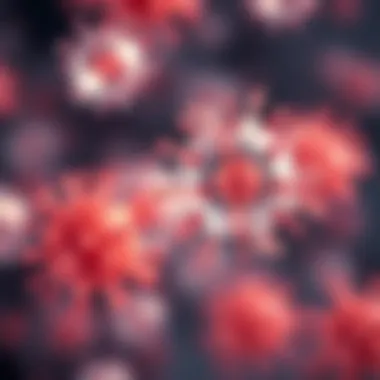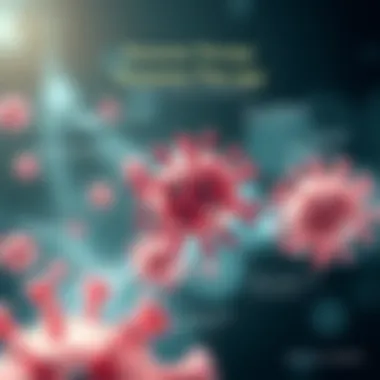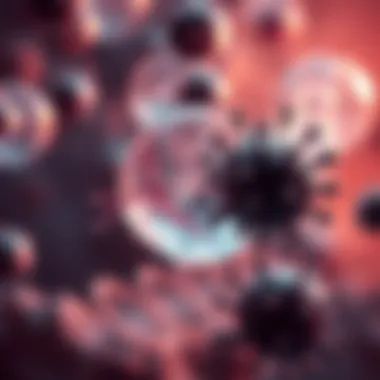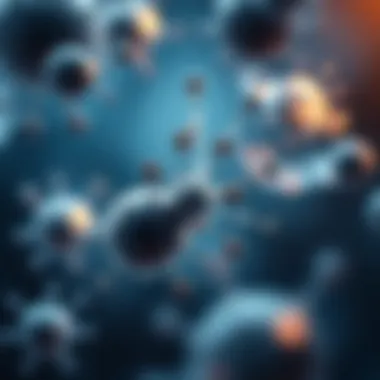Exploring Exosome Therapy: Mechanisms and Applications


Intro
Exosome therapy stands at the crossroads of innovation and practical medicine. As researchers dive deeper into the molecular intricacies of exosomes, attention gradually turns to their potential in various therapeutic applications. Exosomes, small vesicles secreted by cells, are increasingly recognized for their role in intercellular communication and their ability to carry biological information and therapeutic cargo. This emerging field is poised to reshape treatment modalities across a range of medical issues, from cardiovascular conditions to neurodegenerative diseases.
In this review, we navigate the multifaceted dimensions of exosome therapy. We aim to illuminate not only the underpinnings of its mechanisms but also the vast array of clinical applications currently under exploration. We will analyze existing research findings while casting a critical eye on the challenges that lie ahead.
As scholars and practitioners delve into the complexities of exosome therapy, it is vital to stay informed about the prevailing trends and future directions. This synthesis of knowledge will provide a roadmap to understanding this evolving landscape. By presenting salient findings, this article endeavors to equip readers with valuable insights into the potential of exosome therapy and its implications in modern medicine.
Preface to Exosome Therapy
In recent years, the spotlight on exosome therapy has grown significantly, captivating the attention of researchers and medical professionals alike. With a promising potential to revolutionize treatment methodologies, exosome therapy offers innovative solutions across various medical disciplines. This section delves into the importance of exosome therapy, providing an essential overview that sets the stage for more in-depth discussions to follow.
Definition of Exosomes
Exosomes, small vesicles ranging from 30 to 150 nanometers in diameter, are extracellular structures released by cells into various bodily fluids such as blood, urine, and saliva. They play a crucial role in intercellular communication and are formed during the inward budding of the cell membrane. These vesicles carry a diverse array of molecular contents, including proteins, lipids, and RNA, which can influence the function of recipient cells. Essentially, exosomes can be viewed as microscopic messengers, relaying critical information between cells and impacting a multitude of biological processes.
Historical Context
The exploration of exosomes began in the early 1980s with the initially humble observation of cellular debris. However, the true significance of these vesicles became more apparent in the late 20th century as advanced techniques in molecular biology became available. Over the past decade, research has rapidly expanded, revealing that exosomes are not mere waste products; instead, they are pivotal to numerous physiological and pathological processes. The transition of exosome studies from the fringes of cell biology to central themes in medical research highlights a paradigm shift towards recognizing small vesicles as key players in health and disease.
Relevance in Modern Medicine
The relevance of exosomes in modern medicine cannot be overstated. First, they are integral in diagnostics, serving as potential biomarkers for diseases ranging from cancer to neurodegenerative disorders. Their presence in body fluids means that samples can be obtained non-invasively, making them a focus of ongoing research for early detection methods. Moreover, the therapeutic applications of exosomes are increasingly being explored, especially in targeted drug delivery systems and regenerative medicine. They possess the unique ability to cross cellular barriers, which enhances their potential as vehicles for delivering therapeutic agents directly to affected cells.
Understanding exosome therapy is crucial as it may unlock novel pathways for treating complex diseases that have eluded conventional therapies.
As we delve deeper into the mechanisms of action, applications, and clinical research surrounding exosome therapy, it becomes clear that this field holds promise not only for advancing medical practice but also for transforming the way we approach treatments and patient care.
Mechanisms of Action
Understanding the mechanisms of action for exosome therapy is crucial because it lays the groundwork for how these cellular messengers can be harnessed for therapeutic purposes. Their role in intercellular communication makes them a fascinating subject in medical research. Delving into the nuts and bolts of exosome function reveals not only their biological significance but also their potential applications across various fields, such as cancer treatment and regenerative medicine.
Biogenesis of Exosomes
Exosomes are tiny extracellular vesicles that originate from the fusion of multivesicular bodies with the plasma membrane of cells. This process is not just a random occurrence; it’s highly regulated and pivotal in cellular homeostasis. The size of exosomes usually ranges from 30 to 150 nanometers. During their formation, they can encapsulate a diverse array of biomolecules, reflecting the biology of the originating cell. This biogenesis is essential as it determines the content of exosomes, which subsequently influences their role in signaling pathways.
The intriguing aspect of exosome biogenesis lies in how they vary across different types of cells. For instance, exosomes produced by immune cells carry distinct markers that play a role in immune response, while those from stem cells promote regeneration. Thus, understanding how these vesicles are formed allows researchers to tailor their use in various therapies.
Cellular Communication and Signaling
Exosomes serve as pivotal players in the communication between cells. They facilitate the exchange of proteins, lipids, and genetic material between cells, acting almost like tiny information packets. The signaling properties of exosomes are significant in numerous biological processes, such as inflammation, tumor progression, and tissue repair.
One fascinating function is their ability to modulate the immune system. By transferring immune-related molecules, exosomes can either stimulate an immune response or help in immune evasion by tumors. This makes them particularly attractive for therapeutic applications; leveraging their signaling capabilities can enhance treatments for various diseases. The dynamic nature of exosome-mediated signaling raises intriguing possibilities for manipulating these pathways in future therapies.
Cargo Contents of Exosomes
Exosomes are often described as cargo ships, transporting an array of biological molecules that are crucial to their function. The cargo typically consists of proteins, lipids, and nucleic acids, each contributing uniquely to the therapeutic potential of exosome therapy.
Proteins
The protein composition of exosomes is a major contributor to their functionality. Proteins within these vesicles can serve numerous roles, such as acting as enzymes, receptors, or signaling molecules. Their specific aspect of cellular signaling is noteworthy; they can influence recipient cells by activating specific pathways that regulate cell growth and differentiation.
One key characteristic is how protein profiles vary between exosomes derived from different cell types. For instance, exosomes from cancer cells often contain proteins that promote tumor growth, while those from stem cells include factors that aid in tissue regeneration. This variability highlights why proteins are such a popular focus in exosome research; their unique features can be harnessed for highly targeted therapies.
Lipids


Lipids play a crucial role in exosome integrity and functionality. They not only form the vesicle membrane but also participate in signaling within the exosomes themselves. The lipid bilayer encapsulates the other cargo, protecting it from degradation while facilitating the release of its contents upon fusion with target cells.
An important aspect is the lipid composition; for instance, sphingomyelin and cholesterol are often prevalent in exosomal membranes, providing stability and fluidity. This unique feature allows for better interaction with the target cell membranes, enhancing delivery efficiency. However, the modulation of lipid profiles can also influence the therapeutic outcome, making it a double-edged sword in therapy.
Nucleic Acids
Nucleic acids, particularly microRNAs (miRNAs), have emerged as a critical component of exosomal cargo. These small, non-coding RNAs can regulate gene expression in recipient cells, effectively altering their behavior. The presence of specific miRNAs in exosomes can influence various pathways associated with cancer progression, inflammation, and metabolic disorders.
The most striking characteristic of nucleic acids in this context is their ability to trigger responses in distant cells. Unlike proteins, which act locally, nucleic acids can have systemic effects, making them powerful tools in therapeutic strategies aimed at diseases requiring extensive intervention. This unique capability also poses challenges regarding specificity and potential off-target effects, which remains a topic of ongoing research.
In summary, understanding the mechanisms behind exosome action—ranging from how they are produced, to how they communicate, and what they carry—provides invaluable insight into their therapeutic potential. The nuances of exosome biology can offer untapped avenues for future medical interventions.
Applications of Exosome Therapy
The applications of exosome therapy present an exciting frontier in modern medicine, underscoring its versatility across various medical disciplines. Exosomes, as tiny extracellular vesicles, serve not only as communication vehicles for cells but also as potential therapeutic agents. By transporting proteins, lipids, and nucleic acids, these vesicles can influence various biological processes, providing targeted treatments. This section explores the significant applications of exosome therapy, specifically in the realms of cancer treatment, regenerative medicine, neurological disorders, and cardiovascular applications. Each domain showcases the potential of exosomes to revolutionize how we approach treatment strategies, ultimately improving patient outcomes.
Cancer Treatment
Mechanisms of Tumor Suppression
One specific aspect of using exosomes in cancer treatment is their role in tumor suppression. Exosomes derived from specific immune cells, such as dendritic cells, carry signals that can inhibit tumor growth. There’s compelling evidence that these exosomes can present tumor antigens to T cells, empowering the immune system to recognize and attack cancer cells effectively. This key characteristic of fostering immune response makes exosome therapy a popular choice in oncology.
The unique feature of using exosome-mediated tumor suppression lies in their ability to enhance the body’s natural defenses without the side effects seen in conventional therapies like chemotherapy. However, challenges exist such as ensuring the specificity of the exosomes targeting only malignant cells without harming healthy tissue. Addressing these downsides will facilitate broader application and acceptance in clinical settings.
Drug Delivery Systems
When it comes to drug delivery systems, exosomes can revolutionize how pharmaceuticals are administered. These vesicles can encapsulate therapeutic agents, such as chemotherapy drugs or RNA-based therapeutics, and transport them directly to target cells. This targeted delivery significantly enhances the efficacy of drug action while minimizing adverse effects. Their key characteristic is the natural ability of exosomes to cross cellular barriers, which traditional delivery systems often struggle with.
The unique benefit of exosomes in drug delivery is their biocompatibility and low immunogenicity, making them less likely to provoke an immune response. On the flip side, challenges include inefficient scaling for large-scale therapeutic production, which is a concern when moving from laboratory studies to actual clinical use.
Regenerative Medicine
Tissue Repair
In the field of regenerative medicine, exosomes derived from stem cells or damaged tissue hold significant promise for tissue repair. These exosomes contain growth factors and bioactive molecules that enhance the healing processes in injured tissues. What makes them an attractive option is their ability to influence multiple repair mechanisms simultaneously, such as reducing inflammation and promoting cell survival and migration.
Their unique feature lies in encouraging the body’s natural repair processes, potentially offering an alternative to surgery or hormone therapies. Nonetheless, tuning the delivery and dosage of exosomes for optimal tissue repair can be tricky and needs meticulous research.
Stem Cell Therapy
Connecting to stem cell therapy, exosomes have emerged as a crucial component in harnessing the regenerative potential of stem cells. They facilitate communication between stem cells and target tissues, thereby enhancing the effectiveness of therapeutic interventions. The key characteristic of exosomes here is their ability to mimic the biological signals stem cells would normally provide.
One of the advantages of using exosome therapy over traditional stem cell treatments is the potential to reduce complications associated with stem cell transplants. However, a concern remains regarding the reproducibility and scalability of manufacturing exosomes, which presents a barrier to widespread clinical use.
Neurological Disorders
The role of exosome therapy in treating neurological disorders is gaining traction as researchers uncover their potential to transport neuroprotective factors and facilitate communication between neurons. These vesicles can traverse the blood-brain barrier, delivering therapeutic agents directly to sites of neuronal damage. Investigating this area is critical, especially for conditions like Alzheimer’s or Parkinson’s disease, where traditional treatments have fallen short. More exploration is needed to understand their precise effects and therapeutic prospects fully.
Cardiovascular Applications
In cardiovascular medicine, exosomes offer potential avenues for repairing damaged hearts and blood vessels. They can carry genomic materials that promote angiogenesis—the formation of new blood vessels—which is vital for healing after cardiac events like heart attacks. By enhancing vascular healing and preventing further damage, exosome therapy could change the landscape of cardiovascular treatments.
In summary, applications of exosome therapy span a wide range of therapeutic areas, providing innovative solutions to complex medical challenges. From cancer treatment to regenerative efforts in cardiology, the promise of exosomes underscores their role as a cutting-edge resource in medicine.
Clinical Research and Trials
The landscape of exosome therapy is rapidly evolving, with ongoing clinical research and trials playing a pivotal role in exploring its vast potential. This segment addresses several critical elements surrounding the clinical investigation of exosome-based treatments. It sheds light on the need for rigorous scientific examination, assesses the benefits that stem from such inquiry, and contemplates the ethical and practical considerations in executing these clinical studies.


Overview of Key Studies
In recent years, the body of research surrounding exosome therapy has expanded significantly. One of the most notable studies involved the use of exosomes derived from mesenchymal stem cells (MSCs) to treat various conditions, including cardiovascular diseases and neurodegeneration. In a particular trial, MSC-derived exosomes were tested for their ability to promote tissue repair in models of myocardial infarction. The results indicated a marked improvement in cardiac function, underlining the therapeutic promise of exosomal delivery systems.
Another key study explored the application of exosomes in cancer treatment. Researchers focused on their role as delivery vehicles for RNA-based therapies, aiming to target and silence oncogenes in tumor cells. The outcomes illustrated how exosomes not only facilitated delivery but also enhanced the potency of the treatments, paving the way for future applications in precision medicine.
Results and Findings
The findings from these pivotal studies indicate a growing momentum in the understanding of exosome therapy. A few compelling points emerged:
- Efficacy: Many trials unveiled that exosome-based treatments significantly improved outcomes in patients with cancer, heart disease, and even chronic inflammatory disorders.
- Safety profile: The majority of studies reported minimal adverse effects, suggesting that exosomes are biocompatible and safe for therapeutic use. This aspect is crucial, as it paves the way for more widespread application in clinical practice.
- Mechanistic insights: It became clear that the unique cargo of exosomes, comprising proteins, lipids, and nucleic acids, plays a pivotal role in mediating their therapeutic effects. Researchers are continuing to unpack how these elements interact at a cellular level, fostering an advanced understanding of their benefits.
Challenges in Clinical Implementation
Despite the encouraging results from clinical studies, there are significant challenges that investigators face when seeking to translate these findings into regular use.
Standardization Issues
A primary concern in exosome therapy is the issue of standardization. There is a marked lack of consensus on how to isolate, characterize, and quantify exosomes, which complicates the background necessary for clinical application. Subsequently, discrepancies in methodological approaches can lead to variable outcomes among studies. The importance of developing standardized protocols cannot be overstated. A uniform set of standards will not only enhance the reproducibility of results but will also help streamline the regulatory process when transitioning from bench to bedside.
Regulatory Hurdles
The path to clinical application is not merely beset by scientific hurdles; regulatory hurdles pose formidable challenges as well. Exosome therapy is positioned in a gray area within existing regulatory frameworks. Determining whether these biological agents should fall under drug or biologic classifications continues to be a contentious subject. Concerns regarding quality control, potency assessments, and long-term follow-up must be thoroughly addressed. Until regulatory bodies establish clear marketing pathways and safety guidelines, progress in bringing these therapies to patients may stagnate.
Exosome therapies hold considerable promise, yet the complexities of clinical implementation must be navigated to realize their full potential.
Efficacy of Exosome Therapy
The landscape of medicine is shifting, and exosome therapy stands at the forefront of this transformation. Its efficacy holds significant weight in how we perceive treatments across various medical domains. This section will uncover the core aspects around the effectiveness of exosome therapies, providing insights into how they compare to conventional therapies and their implications in ensuring long-term patient wellness.
Comparative Effectiveness
When delving into the comparative effectiveness of exosome therapy, it's crucial to consider how this approach stacks up against traditional treatments. In many cases, exosomes have demonstrated better outcomes due to their unique properties. For instance, exosomes can deliver therapeutic agents more selectively to target cells, thus enhancing the efficiency of drug delivery systems. Furthermore, they tend to exhibit fewer side effects compared to standard treatments.
Recent studies have indicated that exosome-based therapies, particularly in the field of oncology, have not only improved patient responses but also provided better quality of life, adding an optimistic perspective to patient care. A notable example includes the use of exosomes derived from mesenchymal stem cells, which have shown a significant reduction in tumor growth in various clinical settings. The ability of exosomes to transfer bioactive molecules facilitates a more intricate interplay within cellular environments, which leads to enhanced therapeutic outcomes.
- Benefits of Exosome Therapy Over Traditional Treatments:
- Higher specificity in targeting diseased cells
- Fewer side effects and toxicity
- Potential for personalized medicine applications
"Exosomes appear to offer a window into a new realm of targeted therapies, representing a promising frontier in treating conditions previously deemed challenging."
Long-Term Outcomes
The investigation into the long-term outcomes of exosome therapy is a critical pursuit, as the implications of this therapy could redefine patient care models. Understanding how these therapies perform over extended periods can powerfully influence patient decisions and clinical applications. Exosome therapy has been shown to promote regeneration and healing in a variety of tissues, proving effective not just in the immediate aftermath of treatment but also contributing to sustained recovery.
For instance, patients undergoing regenerative treatments with exosomes have displayed improved functionality in damaged tissues, suggesting that the benefits do not plateau quickly but may continue to evolve positively over time. This longevity of effect is particularly notable in neurological and cardiovascular applications, where long-term improvements can profoundly affect recovery and quality of life.
Research across a spectrum of studies indicates that patients receiving exosome therapy often experience:
- Increased tissue regeneration
- Sustained relief from symptoms
- Enhanced overall patient well-being
Consequently, as more studies unravel the long-term capabilities of exosome therapy, it could become increasingly integrated into standard care regimens, transforming routine practices into more cutting-edge, effective treatments. The trajectory of exosome therapy underlines a vital shift within the medical paradigm, encouraging ongoing research and evaluation.
Ethical Considerations


Understanding the ethical considerations surrounding exosome therapy is paramount as this field continues to grow. The relevance of ethics in medicine cannot be overstated; it serves as the backbone for trust, dignity, and patient welfare. With advanced technologies evolving rapidly, ensuring ethical integrity becomes even more crucial.
Ethics in Research and Development
Exosome therapy, like any innovative treatment, involves a landscape where ethical dilemmas can arise. Researchers must traverse various obligations, from protecting participant rights to ensuring the accuracy of their findings. This isn’t just about meeting a checklist of regulatory requirements; it’s about fostering an environment of respect and responsibility.
Researchers engage in numerous pre-clinical studies and clinical trials, pushing the boundaries of how exosomes can help in disease management. However, the ethics behind these processes call for careful scrutiny. For instance, researchers must consider how the use of human-derived exosomes impacts patient populations and what consent processes look like.
Furthermore, with the increased interest in cell-based therapies, it's vital to address potential conflicts of interest. If researchers are tied to commercial entities developing these therapies, biases might inadvertently influence study outcomes. Engaging independent boards for oversight can help mitigate such issues, ensuring that scientific integrity is not sacrificed.
Patient Consent and Transparency
Another critical aspect of ethical considerations in exosome therapy relates to patient consent and transparency. Patients who participate in clinical trials or new treatments must be fully informed about what they are entering into. This goes beyond the basic explanations and must encompass potential risks, benefits, and unknowns associated with exosome therapy.
For example, patients should be aware of the ways in which exosomes are harvested, processed, and utilized. The journey from lab bench to bedside should not be a mystery; educating patients on how these processes work is essential for informed consent. When patients understand the treatment's nuances, they can make more informed choices about their participation.
Moreover, the importance of transparency transcends the patient-provider relationship. It also involves communicating with the wider community about the implications of exosome therapy. Institutions should publish their findings, both successful and unsuccessful, contributing to a growing body of knowledge that benefits everyone involved.
“An informed patient is often a more recuperative patient, for knowledge is a powerful tool in the healing process.”
In summary, ethical considerations in research, patient consent, and transparency are crucial facets surrounding exosome therapy. Addressing these elements not only enhances patient trust but also strengthens the overall integrity of modern medical practices. As the field continues to evolve, a steadfast commitment to ethics ensures that advancements are aligned with the fundamental principles of medical practice.
Future Directions in Exosome Therapy
The domain of exosome therapy is expanding rapidly, and the prospects for its future look exceptionally promising. Understanding the future directions in exosome therapy is crucial, as it will shape the development of new therapeutic strategies and potentially revolutionize how we approach healthcare. This section will delve into emerging technologies that may enhance the efficacy of treatments involving exosomes, as well as explore potential new applications that could tap into the full range of benefits offered by these tiny vesicles.
Emerging Technologies
Advancements in technology play a pivotal role in the evolution of exosome therapy. Various tools and methodologies are being adapted or developed to improve the isolation, characterization, and delivery of exosomes. For instance, novel purification techniques such as size-exclusion chromatography and microfluidics allow more precise and efficient extraction of exosomes from biofluids. Not only does this enhance the purity of exosomes, but it also maximizes their functional profile which is vital for therapeutic interventions.
Another noteworthy advancement is the use of CRISPR-Cas9 technology in genetic engineering of exosomes. This technique can potentially modify exosomes to enhance their therapeutic efficacy. Scientists can insert specific genetic sequences into exosomes, allowing them to target certain cells or pathways more effectively. This capability could be crucial for precision medicine, where treatments are tailored to individual patient profiles, streamlining therapeutic outcomes.
Moreover, developments in molecular imaging are expected to bolster the tracking of exosome biodistribution and cellular interactions in real-time, providing insights that can enhance therapeutic protocols. In short, the landscape of exosome therapy may soon be sculpted by these emerging technologies, paving the way for more effective and personalized treatments.
Potential New Applications
As the understanding of exosomes grows, the potential applications for therapy continue to expand. Exosomes are no longer just considered vessels for transport; they are being recognized as active players in numerous biological processes, opening doors to numerous applications:
- Autoimmune Diseases: Exosome therapy holds great promise in treating autoimmune disorders. By harnessing the immunomodulatory properties of exosomes, researchers can potentially develop therapies that can mitigate the adverse effects of autoimmune reactions.
- Infectious Diseases: Another exciting area involves the application of exosomes in combating infectious diseases. Exosomes derived from immune cells could potentially deliver antiviral agents directly to infected tissues, enhancing the body’s natural response mechanisms against pathogens.
- Gene Therapy: Exosomes are being explored as vectors for gene therapy as well. By encoding therapeutic genes within exosomes, it's possible to deliver genes to specific tissues, offering new avenues for treating genetic disorders.
“The future of exosome therapy could redefine treatment paradigms across a spectrum of diseases.”
As these potential applications become more fully realized through ongoing research, practitioners may findexosome therapy becomes an integral part of standard medical practice. This shift will respond not just to the biological potential of exosomes but also to a broader demand for innovative, effective, and minimally invasive therapies in modern medicine.
Culmination
In sum, the landscape of exosome therapy stands as a beacon of hope and innovation within modern medicine. Its unique mechanisms and applications hold promise for various medical fields, suggesting a future where treatments are more tailored to individual patients. This conclusion aims to distill the core findings of our exploration of exosome therapy, emphasizing the significance of continued research and ethical considerations within this evolving domain.
Summary of Key Insights
Exosomes act as natural carriers of therapeutic materials, showcasing their potential for targeted drug delivery and regenerative medicine. Key insights derived throughout the article highlight:
- Mechanisms of Action: The ability of exosomes to facilitate intercellular communication contributes to their therapeutic effects, making them essential for effective cancer treatments and regenerative approaches.
- Clinical Applications: Exosome therapy has gradually expanded from laboratory research into practical applications in treating various diseases, particularly cancer, cardiovascular issues, and neurological disorders.
- Ethical Implications: While the promise is significant, ethical considerations surrounding patient consent and research integrity remain paramount in the pursuit of this rapidly advancing field.
Acknowledging the need for rigorous exploration, it is imperative to consider both the successes and challenges faced in this area, as advancing knowledge will enable practitioners to harness the full potential of exosome therapy.
The Future Landscape of Exosome Therapy
Looking ahead, the field of exosome therapy is at a pivotal juncture, ripe with opportunity yet fraught with challenges. Several emerging trends and potential developments could radically reshape our approach to treatment:
- Biotechnological Innovations: Advances in biotechnologies are likely to enhance the precision and efficacy of exosome isolation methods, ultimately leading to more effective therapies.
- Personalized Medicine: As understanding deepens, we can expect a shift toward personalized treatments that harness the unique properties of each patient's exosomes, tailoring therapies to individual needs.
- Expanded Applications: Beyond the current applications in oncology and neurology, exosome therapy holds potential in fields like autoimmune diseases, infections, and genetic disorders.
"In the brave new world of exosome therapy, the key to unlocking its potential lies in a balanced approach to ethical concerns and innovative research."



